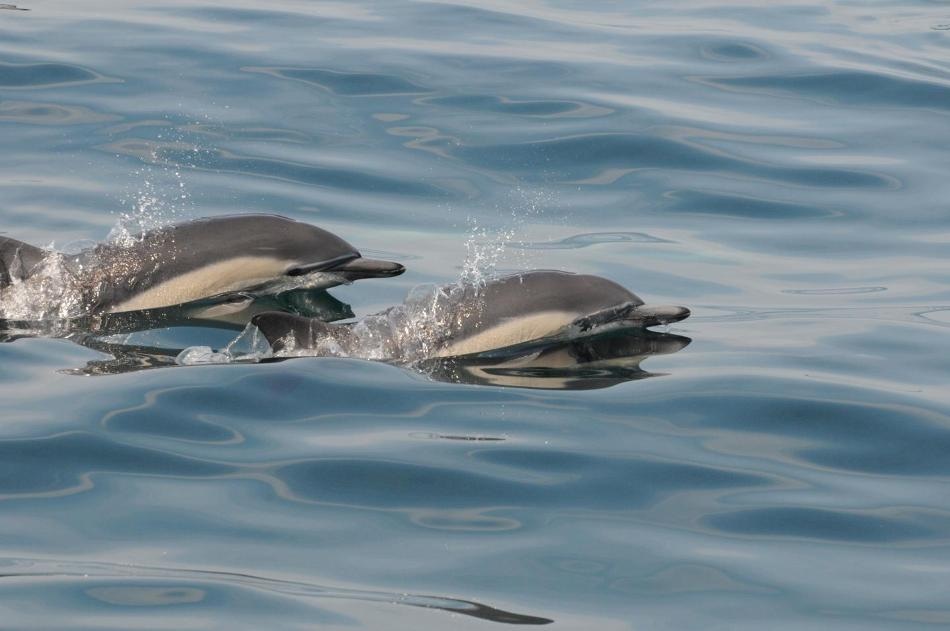Oct 20 2017
An innovative study has demonstrated that environmental changes such as El Niño disturb the marine food chain at Southern California. This finding is contrast to traditional notion that the hierarchy of food chain in the ocean is mostly unaltered as time passes.
 Two common dolphins swimming in synchrony alongside the NOAA R/V Shearwater in the Santa Barbara Channel in August 2017. CREDIT: Photo by Lindsey E. Peavey (NOAA CINMS).
Two common dolphins swimming in synchrony alongside the NOAA R/V Shearwater in the Santa Barbara Channel in August 2017. CREDIT: Photo by Lindsey E. Peavey (NOAA CINMS).
The study has been reported in the Science Advances journal and investigated the skin cells of common dolphins to obtain chemical indicators related to the length of the marine food web, at the base of which are tiny plankton. Dolphins, which are huge predators, are positioned on top of the food chain. The cells of the dolphins include chemical information related to all the species positioned below them.
For a long time now, Researchers have been of the notion that the length of the food chain in the open ocean is almost stable, with practically the same animal species feeding on one another over time. According to Researchers from NOAA Fisheries, Moss Landing Marine Laboratories, and the Scripps Institution of Oceanography, however, the chemical information in the skin of dolphins in Southern California gathered over a period of 20 years indicates that it is not so.
“We documented for first time marked changes in the pelagic food web length in response to various natural and anthropogenic related stressors,” stated Rocio I. Ruiz-Cooley, Lead Author of the study, who was earlier affiliated with NOAA Fisheries’ Southwest Fisheries Science Center and is now at Moss Landing Marine Laboratories. “This tells us that the food web is very dynamic, and reveals changes with the ecosystem around it.”
She stated that the discovery assists Researchers in achieving in-depth knowledge of the resilience and health of the ecosystem. A longer food chain is normally a characteristic one, indicating an almost diversified community. In contrast, shorter food chains are caused in the context of severe environmental conditions and indicate deterioration in the diversity.
Researchers found that in the course of extreme climate disturbances—for example, the 1997–1999 El Niño Southern Oscillation that involved the most severe El Niño event of the 20th century that led to the atypical warming of the West Coast of the United States—the food chain in the California Current was acutely shortened. This corresponded to decreases in ocean productivity, for example, decreased plankton growth, decline in specific birds and fish, as well as increases in specific species such as jumbo squid, possibly because they looked for scarce food or traveled to areas with more conducive temperatures.
“These changes in life history traits and population dynamics likely reduced and/or removed populations of many species, including important components of the food web,” thereby shrinking the food chain, reported the Researchers in the latest report. Predators could have aggravated this effect as they consumed the left out species, thus reducing the length of the food chain supporting them. Despite the fact that specific species (e.g. jellyfish and tunicates such as salp) might proliferate rapidly for closing such gaps, they offer very little nutrition, hence majority of the predators do not feed on them, thereby cutting the food chain short.
According to Ruiz-Cooley, the research shows that major predators such as common dolphins can be significant indicators of the food chain length, thereby providing in-depth knowledge of the ecosystem. The research investigated the skin tissue samples, from the Southwest Fisheries Science Center, collected from dolphins accidentally caught in gillnets near Southern California in the period 1991-2008, emphasizing the value of the tissue collection over time.
This research, and the results it has produced, illustrate the great value of this time series reflected in the cell samples. As technology advances, we can extract even more information from the time series as a window into the past, and a baseline to address tomorrow’s emerging issues.
Lisa Ballance, Co-author of the paper and Director, Marine Mammal and Turtle Division, The Science Center